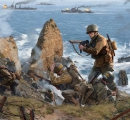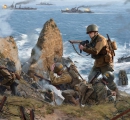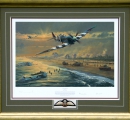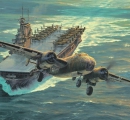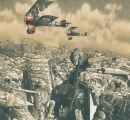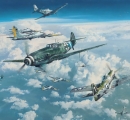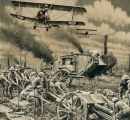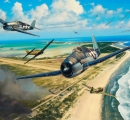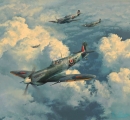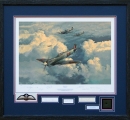Advanced Search
Use the advanced searches below to find what you are looking for. To select multiple signatures just hold down the Ctrl key on your keyboard and select the signatures by clicking on them. Then click the Search button.
The Allies believed Pointe du Hoc to be the most dangerous battery on the Normandy coast. If the D-Day landings were to succeed, the guns that threatened the American beaches had to be destroyed.
Sited on a high rocky headland jutting out into the sea four miles to the west of...
The Allies believed Pointe du Hoc to be the most dangerous battery on the Normandy coast. If the D-Day landings were to succeed, the guns that threatened the American beaches had to be destroyed.
Sited on a high rocky headland jutting out into the sea four miles to the west of Omaha beach, Pointe du Hoc would be a tough nut to crack. Despite...
A pair of Spitfires from 412 Canadian Sqn whistle over Juno Beach in support of the 3rd Canadian Division storming ashore below. By the end of the day more than 21,000 men had landed on Juno, the second most heavily defended of all the D-Day beaches, with the Canadians advancing further inland than any other Allied troops.
Personally singed by two Spitfire pilots who flew combat...
COMMEMORATING THE 75th ANNIVERSARY OF THE DOOLITTLE RAID - 18 APRIL 1942
PUBLISHED IN ASSOCIATION WITH THE DOOLITTLE RAIDERS
The daylight raid on Tokyo, led by Lt Col James H. Doolittle on Sunday 18 April 1942, has rightfully entered the history books as one of the most daring and courageous operations of the Second World War. On that day, in...
COMMEMORATING THE GREAT WAR 1914 – 1918
In the early hours of Thursday 21 March 1918 a thunderous barrage shook the Western Front. In the space of just five hours a million artillery shells – over 3000 every minute – detonated amidst the lines held by an exhausted and overstretched British Fifth Army which, by the Spring of 1918, had found itself in...
14 January 1945; and the war was not going well for Germany. The noose was tightening as American, British and Canadian armies, having broken out from their Normandy landings seven months earlier, stood on the banks of the Rhine. In the east vast numbers of Russians were driving relentlessly towards Berlin. On their bomb-cratered airfields the Luftwaffe prepared for the final onslaught...
THE SECOND IN A SERIES COMMEMORATING THE GREAT WAR 1914 – 1918
On Friday 15 September 1916, during the Battle of the Somme, a new, unnerving sound was heard on the Western Front; a deep mechanical rumble accompanied by the ominous clanking of metal. Approaching their trench positions on the front line between the villages of Flers and Courcelette, German soldiers could see...
On 23 December 1941, just days after their infamous attack on Pearl Harbor, the Japanese captured Wake Island, a small, but strategic coral atoll in the western Pacific.
The small garrison of mainly US Marines had already repulsed one landing but, on 23 December, the Japanese succeeded. Wake fell, as had Guam before it and now, across the breadth of the south-west Pacific, islands...
Released on the 100th Anniversary of the RAF as a tribute to all those who flew the Spitfire!
When the Luftwaffe unleashed the Fw190, the unsuspecting Spitfire pilots of RAF Fighter Command were at serious disadvantage – but it wasn’t for long!
Under clear skies, a light breeze from the south-west blew across the...
One of the first units to re-equip with new Mk.IX Spitfire was 64 Squadron, and this classic masterwork depicts the day when the RAF hit back against the Fw190s of the Luftwaffe. It was 30 July 1942 over Boulogne when 64 Squadron, acting as top cover, spotted a group of a dozen Fw190s about 2,000ft below them. Bouncing the enemy from above, Don Kingaby, one of the RAF’s most iconic...

